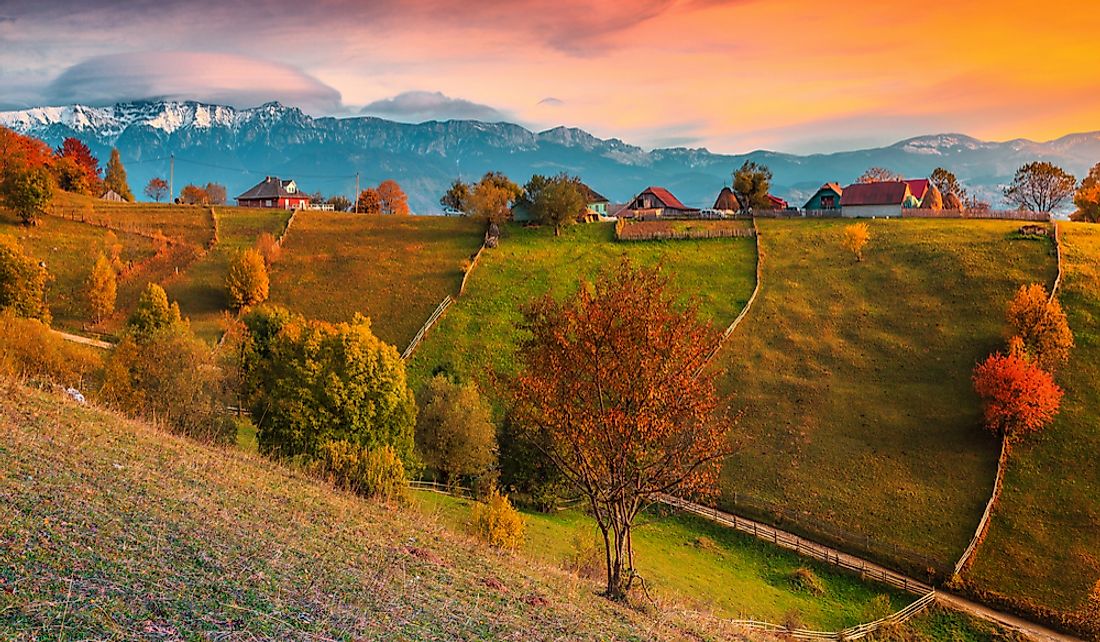What Type Of Climate Does Romania Have?

Romania is a European country situated at the crossroad of Southeastern, Eastern, and Central Europe. It is bordered by the Black Sea to the northwest, Bulgaria to the north, Ukraine to the south, Hungary to the east, Moldova to the west, and Serbia to the northeast. Romania has a total area of approximately 92,046 square miles, making it the 12th largest country in Europe. It is the 7th most populous country in the EU with a population of 20 million people. The country’s largest and capital city is Bucharest, situated in the southeastern part of Romania, approximately 37 miles north of the Danube River. Romania's location and geography greatly influence its climate.
Geography of Romania
Geography is one of the most important factors affecting the climate of a region. Romania is located in Southeastern Europe and is approximately halfway between the North Pole and the Equator. The country’s natural landscape is divided among the hills, plains, and mountains. The arc of the Carpathians stretches over 621 miles through the center of the country and covers an area of approximately 27,413 square miles. These mountains may reach an elevation of 2,500 meters above sea level. The Carpathian Mountains are divided into three ranges; Eastern, Southern, and Western Carpathians. Each of these ranges has important distinguishing features. Romania has several rivers, most of which are tributaries of the Danube River. The Danube River is the longest river in the country, traveling for some 668 miles within the Romanian territory. Other rivers include Mures, Prut, Olt, Lalomita, Siret, and Somes.
Climate of Romania
Because Romania is located on the southeastern part of the continent of Europe, its climate is transitional between continental and temperate. The country’s climate has been modified by the relief, with the Carpathian Mountains serving as a barrier to Atlantic air mass. These mountains also block the influence of the vast plains to the north in Ukraine which is responsible for the less rain and frosty winter in the south. The climate is mainly influenced by the Black Sea weather, Mediterranean climate, and Scandinavian-Baltic weather. The southern part of the country experiences the Mediterranean climate characterized by high rainfall in autumn and mild winters. The Black Sea climate is experienced in the southeast while the continental climate is less pronounced in the eastern region. The Scandinavian-Baltic is felt in the north with the western region experiencing moderate weather characterized by moderate temperature and higher precipitation.
Temperature And Precipitation
The annual average temperature of Romania is 11 °C in the south and mid-south regions and 8 °C in the northeastern region. In the capital Bucharest, the temperatures range from -5 °C to 29 °C in January and July respectively, with averages of -3 °C in January and 23 °C in July. Although adequate rainfall is received throughout the country, it decreases from mountains to plains and west to east. Some area around the mountains receives over 40 inches of precipitation annually compared to the country’s annual average precipitation of about 29.5 inches. Owing to Romania’s distance from an open sea, the country experiences a continental climate where summers are generally warm to hot with temperatures reaching 35 °C in low-lying areas. Winter is colder with average highs even in low-lying areas.
Seasons
Romania has all the four conventional seasons; winter, summer, spring, and autumn. However, only the summers and winters are more pronounced than the other two seasons. Spring is the most awaited season in Romania, noticeable for cool mornings and warm days. Autumns are always dry but the temperatures are lower than in spring. The fields are usually characterized by tree producing colorful foliage.
Winter
The winter season begins from December and runs until February. This season is generally cold throughout the country and the skies are often cloudy. Snowfall is common in most places but not abundant, especially in the inland plains. Bucharest is always covered in snow. Temperatures are fairly uniform across the continental regions during winter and decreases as the altitude increases. In cities located around sea levels like Iasi, Bucharest, Timisoara, Craiova, and Galati, daily temperatures in January average -2 °C. In the west of the Carpathian, winters are colder, with temperatures averaging -3 °C in January. Romania, like most parts of the Balkan Peninsula, is exposed to the outbreaks of cold air masses from Russia, mostly in winters. These cold air masses can lower the temperatures to below -20 °C .
Summer
The summer season, running from June to August, is generally warm in the north, hills of Transylvania, and regions east of Carpathian with the temperature reaching 28 °C . The regions south of Carpathian are warmer and hot with maximum temperature in July and August reaching 30 °C or higher. In the coastal areas of the Black Sea, the weather is pleasantly warm and sometimes hot. Summer is generally a rainy season because of the thunderstorms experienced mainly in the afternoon between May and July. Sometimes the thunderstorms are so frequent that they cause floods. Lowlands receive a lot of sunshine while the mountains and Transylvania are often covered in clouds with the sun shining in these areas mainly in the morning.
Climate of Bucharest
Bucharest is located along the banks of the Dambovita River, in the northeastern corner of the Romanian Plains, an area that was once a forest. The city experiences a humid tropical climate characterized by warm, humid summer and snowy winter. Because of its location in the Romanian Plains, the winters are sometimes windy. Temperatures during the winter season always fall below 0 °C while in summer the temperature averages 23 °C. In mid-summer, it is not uncommon for the temperature to reach 35-40 °C. Although Bucharest has low humidity and precipitation in summer, heavy storms occur occasionally. During the autumn and spring season, the temperature during the day vary from 17-22 °C and precipitation tends to be higher in spring than in summer.











